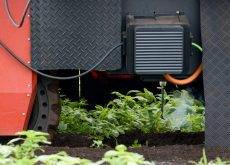The debate over biotech seeds is about to fade away in the rearview mirror as scientists and farmers embrace gene editing.
With the upcoming release of the Canadian Food Inspection Agency’s guidance on gene editing, we have an opportunity to accept a technology that will keep food abundant and affordable in a world suffering from the stresses of war, weather events and food insecurity.
This technology holds incredible potential. Last month, I travelled to Brussels for a gathering of farmers, who described how plant breeding could improve their lives and the food security of their nations.
Read Also

Bunge’s crop mix is changing
Bunge has predominantly been a soybean processing firm, but that’s about to change after the merger with Viterra with softseed processing and grain merchandising gaining ground.
Gilbert Bor of Kenya said plant breeding could deliver pest-resistant crops. Guillermo Breton of Mexico talked about how this new technology will improve niche crops that are better adapted to the soil and climate of his country. Diana Lenzi of Italy discussed the possibility of gene editing allowing her to grow grapes that are protected from pests. David Danio pleaded for seed innovation that would provide food security for the Philippines.
At the top of my wish list is drought resistance. Saskatchewan starts out dry, but we’ve now struggled through seven years of abnormal dryness on my farm. We have no idea when or if this drought will end. We’d love for innovations in plant breeding to help us fight through the hard times with crops that are as resilient as the people who farm them.
Gene editing can make targeted changes to a plant’s DNA. They give plant geneticists the tools to work with the existing genome of a crop, searching for native genes that might, for example, unlock disease resistance.
Gene editing is simply an extension of conventional breeding, which is the kind of breeding that farmers have practiced for millennia. They use the same approaches that allowed ancient farmers across generations to transform little red berries into big and delicious tomatoes — a crop that can’t survive in the wild but can flourish in cultivation and become a staple.
Developing a single new trait for a crop through conventional breeding methods can take a decade, if everything goes smoothly. Gene editing allows us to move quickly with precision and deliberation.
For me, as a farmer in Saskatchewan, it provides an amazing opportunity.
Innovation in plant breeding lets us push the “get’er done” button. We won’t have to wait a decade or more for baby-step improvements. The costs of inputs on my farm are not going down, and seed varieties that allow me to use less pesticide and fertilizer are good for my family and our land.
Unfortunately, Canada is falling behind, and farmers in the United States, South America and Japan are already growing gene-edited crops.
We have an opportunity to catch up. To do so, we need the CFIA to update its plant breeding policies to include gene editing. By treating gene-edited plants like any other similar plant, the CFIA can ensure that Canada remains science-based and pro-innovation. This would enable us to unlock the potential of gene editing in all the crops we grow in Canada, including smaller crops that have previously underperformed.
In an era of rapid population growth, urbanization and threats to the environment, gene editing allows us to meet the needs of people and conserve our natural resources. We should all get behind this opportunity to put the fear of seed innovation in the rearview mirror.
Cherilyn Nagel and her family own a diversified grain farm near Mossbank, Sask.















